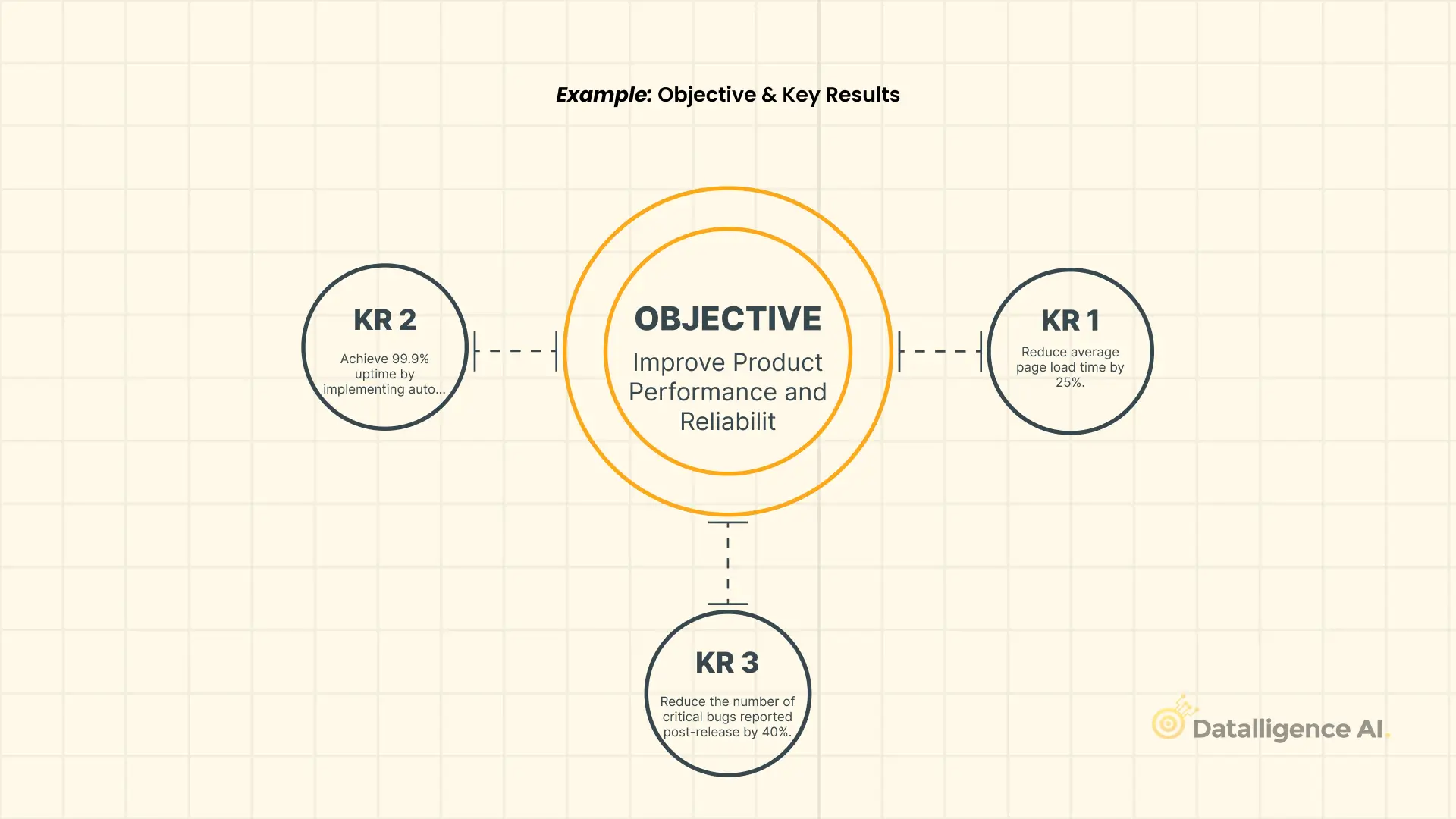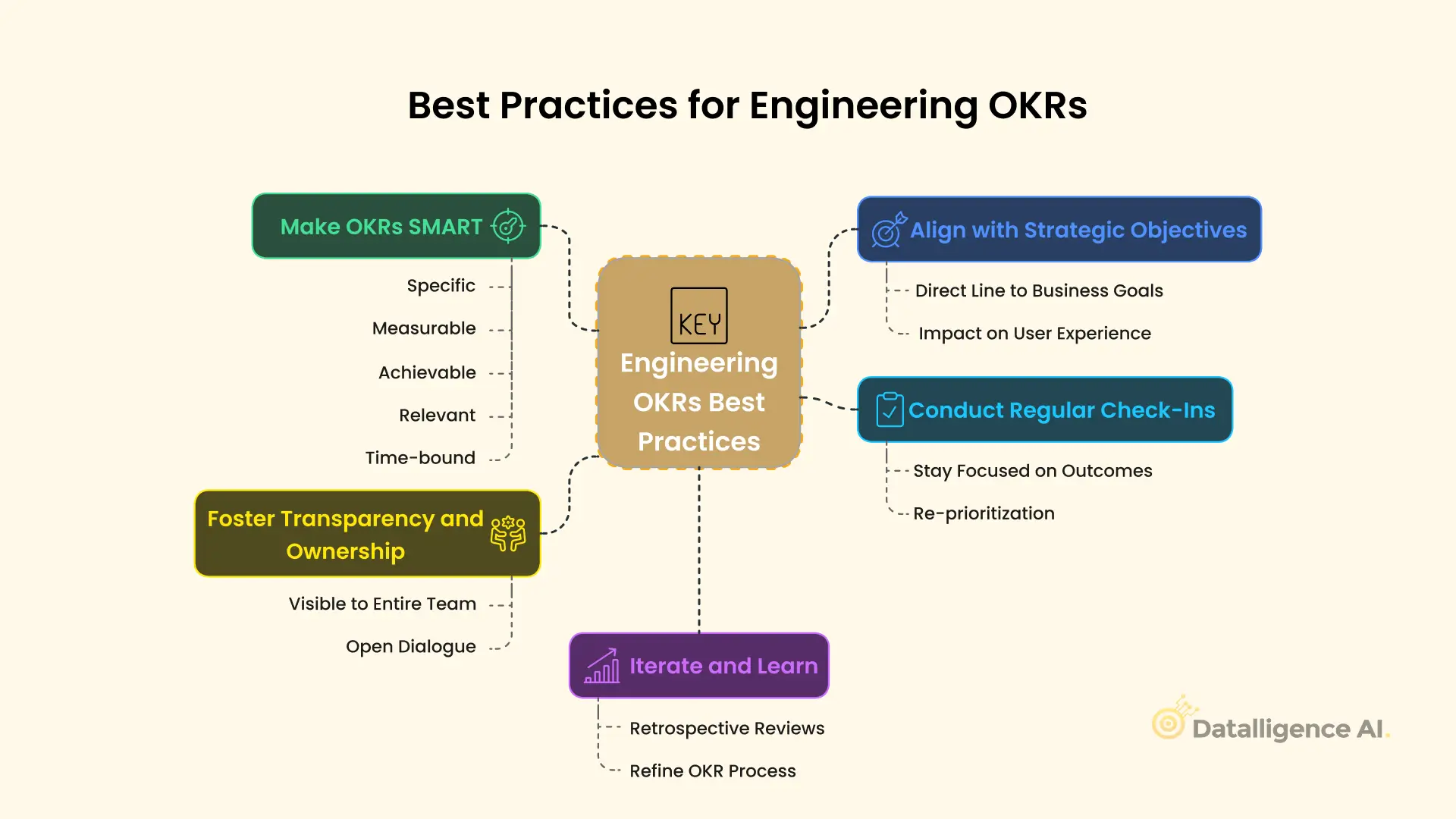Engineering OKRs (Objectives and Key Results) provide a powerful framework to align engineering teams with organizational goals. While project-tracking tools, issue trackers, and bug-monitoring systems serve as a “single source of truth” for tasks, an engineering OKR example demonstrates how these goals go beyond task management. They help anchor engineering efforts to higher strategic outcomes, ensuring teams focus on impact rather than just execution.
Lets explore more on the Best OKR management tool businesses and how that help in scaling businesses in 2025, we’ll explore how engineering OKRs can coexist with project-tracking tools, address common sources of resistance, and provide examples that help teams set strategic objectives while managing tactical demands.
Why OKRs Are More Than Project Tracking
Project tracking and bug-tracking tools—like JIRA, Asana, or Trello—are essential for day-to-day engineering workflows. They handle tactical items: specific tasks, issue logging, and project milestones. But OKRs go beyond tracking individual tasks. They set a clear, strategic direction for what engineering teams should achieve within a period, helping answer why certain work is prioritized.
The misconception that “project tracking tools are enough” often stems from a few factors:
- Misunderstanding the Role of OKRs: Engineers may view OKRs as redundant if they already have a list of tasks and tickets. However, while tasks are tactical, OKRs provide a vision that ensures tactical efforts contribute to the company’s strategic objectives.
- Challenges with Bottom-Up Alignment: Engineering teams may struggle with how their work contributes to overarching goals. When aligning team OKRs with organization-wide objectives, tactical issues often surface, as projects may have dependencies or operational constraints that require negotiation.
- Cultural Resistance to Goal-Tracking: Some teams may feel that OKRs add pressure or impose unrealistic goals, viewing project completion as sufficient. It’s essential to establish OKRs that are aspirational yet feasible and to clarify that OKRs are about outcomes, not micromanagement.
Setting Engineering OKRs That Work
To make OKRs impactful for engineering teams, they should be both ambitious and directly tied to the engineering team’s contributions toward larger business objectives. Having a simple OKR Management Tool can help in linking the projects to OKRs Here are examples of OKRs that help engineering teams see beyond projects:

Example Objective 1: Improve Product Performance and Reliability
- KR1: Reduce average page load time by 25%.
- KR2: Achieve 99.9% uptime by implementing automated monitoring and proactive issue resolution.
- KR3: Reduce the number of critical bugs reported post-release by 40%.
Why it works: This OKR aligns the team’s focus on strategic improvements that directly impact user experience and product reliability, beyond simply closing tickets.
Example Objective 2: Foster Innovation and Technical Excellence
- KR1: Implement at least two new technology frameworks that improve development efficiency by 20%.
- KR2: Conduct bi-weekly innovation sessions and integrate one new idea per quarter.
- KR3: File one patent for a novel engineering solution.
Why it works: These key results encourage innovation beyond the daily grind of issue tracking, allowing engineers to explore and implement impactful technical improvements.
Overcoming Challenges in Setting and Tracking OKRs
- Balancing Project Deliverables with Strategic Objectives: OKRs should not replace project tracking; rather, they should provide high-level focus. For example, if the project involves a major system overhaul, an OKR might focus on “Enhancing Scalability and Efficiency of Systems,” with KRs focused on measurable performance improvements instead of task completion.
- Building Bottom-Up Alignment: Successful OKR alignment involves connecting individual contributors’ goals to team-level and organizational-level objectives. For instance, if an organizational goal is to “Enhance Customer Satisfaction,” an engineering OKR could be, “Reduce bugs in customer-facing features.” Teams can then identify which tactical projects align with these outcomes, like reducing defect counts or optimizing response time for high-impact pages.
- Regular Check-Ins for Continuous Alignment: Establishing a rhythm for OKR check-ins, such as monthly or bi-weekly reviews, helps keep OKRs relevant and allows for mid-course adjustments. Teams can assess whether their project work is moving the needle on the OKRs and, if necessary, adjust their focus or re-prioritize.
Practical Examples of OKRs by Engineering Team Type
Software Development Team
- Objective: Enhance Product Usability and Customer Experience
- KR1: Improve customer satisfaction score from 4.2 to 4.5.
- KR2: Reduce average response time of high-impact features by 30%.
- KR3: Conduct usability testing for 3 critical workflows and implement key recommendations.
Quality Assurance Team
- Objective: Improve Release Quality
- KR1: Achieve test coverage of 95% for all critical components.
- KR2: Reduce the defect rate in production by 25%.
- KR3: Automate 80% of regression tests to ensure quality consistency.
Infrastructure and DevOps Team
- Objective: Optimize System Performance and Uptime
- KR1: Implement multi-region failover capabilities to ensure 99.99% uptime.
- KR2: Reduce deployment time by 40% through CI/CD improvements.
- KR3: Achieve zero downtime in production deployments for the next three quarters.
Here are 10 impactful OKR examples specifically for engineering teams, designed to drive alignment with organizational goals, enhance productivity, and improve system performance and reliability
1. Objective: Improve System Reliability and Uptime
- KR 1: Increase system uptime from 99.8% to 99.95% by implementing multi-region redundancy and failover mechanisms.
- KR 2: Reduce incident response time from 15 minutes to 5 minutes by optimizing alerting and response protocols.
- KR 3: Achieve a post-incident review completion rate of 100% within 48 hours for all critical incidents.
2. Objective: Enhance Development Speed and Efficiency
- KR 1: Reduce average code review turnaround time from 3 days to 1 day by introducing automated code quality checks and peer-review standards.
- KR 2: Implement automated testing in CI/CD pipeline to cover 80% of critical code paths, cutting deployment cycle time by 30%.
- KR 3: Increase story point delivery rate by 20% per sprint without increasing the defect rate, through sprint planning and retrospectives.
3. Objective: Reduce Bugs and Improve Code Quality
- KR 1: Decrease critical bug count by 40% quarter-over-quarter by increasing test coverage and implementing code quality tools.
- KR 2: Ensure 95% of bugs are detected in staging or testing environments before production deployment.
- KR 3: Complete technical debt reduction initiatives targeting high-impact modules, achieving a maintainability score of 85 or above on SonarQube.
4. Objective: Improve Product Performance and Scalability
- KR 1: Reduce API response time from 300ms to 150ms for 90% of requests by optimizing code and database queries.
- KR 2: Achieve 40% more server throughput by implementing efficient load balancing and caching solutions.
- KR 3: Decrease server cost per user by 20% through infrastructure optimization and improved resource allocation.
5. Objective: Drive Innovation and Technical Excellence
- KR 1: Conduct two innovation sprints to explore and develop proof-of-concept for emerging technologies applicable to our product.
- KR 2: File at least one patent for a novel technology or methodology.
- KR 3: Implement a knowledge-sharing system where team members contribute at least one technical insight or innovation each month.
6. Objective: Improve Customer Satisfaction through Product Quality
- KR 1: Achieve a customer-reported bug rate of less than 1% by refining the bug-tracking process and implementing customer feedback loops.
- KR 2: Reach an average customer satisfaction score of 4.5 or higher by resolving major issues and incorporating high-impact feature requests.
- KR 3: Increase average net promoter score (NPS) for product reliability from 30 to 40.
7. Objective: Optimize Infrastructure and Reduce Downtime
- KR 1: Achieve zero downtime during deployment windows by implementing a robust canary deployment strategy.
- KR 2: Reduce infrastructure cost by 15% by optimizing cloud storage and compute resource allocations.
- KR 3: Improve deployment success rate to 98% by introducing automated rollback and recovery mechanisms.
8. Objective: Build a Robust Security Posture
- KR 1: Implement vulnerability scans and conduct penetration tests quarterly, with a 100% remediation rate for critical issues within 72 hours.
- KR 2: Achieve 100% compliance with security best practices for password management, encryption, and access control by the end of the quarter.
- KR 3: Reduce phishing attack susceptibility by 50% through security training and simulated phishing campaigns.
9. Objective: Increase Engineering Team Productivity
- KR 1: Decrease time spent on repetitive tasks by 25% by automating routine processes like deployment, testing, and monitoring.
- KR 2: Implement a “No Meetings Wednesday” policy, increasing the number of focused hours for engineers by at least 15%.
- KR 3: Conduct bi-monthly team retrospectives with 100% participation to address bottlenecks and continuously improve team workflows.
10. Objective: Improve Knowledge Sharing and Documentation
- KR 1: Increase the number of technical documentation pages from 50 to 100, with contributions from at least 80% of the team.
- KR 2: Conduct weekly knowledge-sharing sessions, with a minimum of 75% attendance, focusing on recent learnings, best practices, and technical skills.
- KR 3: Ensure 100% of new engineers onboarded have completed the updated documentation training within their first month.
OKRs for Developers
These OKRs aim to streamline development processes, reduce time on repetitive tasks, and improve overall productivity.
- Objective: Automate Routine Development Processes
- KR 1: Identify and implement automation for at least 3 repetitive coding tasks or workflows (e.g., code formatting, dependency updates).
- KR 2: Set up automated deployment pipelines with 100% error-free deployment rate for major features.
- KR 3: Decrease manual testing time by 30% through automated test coverage on core modules.
- Objective: Improve Code Quality and Reduce Rework
- KR 1: Increase unit test coverage on existing codebase by 20% to reduce time spent debugging.
- KR 2: Reduce code review feedback loops by 25% by adhering to coding standards and best practices.
- KR 3: Create a checklist for development best practices and complete 100% adherence across all new code.
- Objective: Optimize Focused Work Hours
- KR 1: Track and report time saved due to “No Meetings Wednesday” policy, aiming for a 15% increase in coding hours.
- KR 2: Complete and close at least 80% of high-priority tasks without interruptions or context switching on Wednesdays.
- KR 3: Schedule all status updates and sprint planning outside of focused work hours.
- Objective: Identify and Eliminate Bottlenecks
- KR 1: Participate in bi-monthly retrospectives with at least 2 actionable improvements suggested per session.
- KR 2: Reduce code merge conflicts by 30% through proactive communication and coordination with team members.
- KR 3: Log all recurring bottlenecks in development to assess and address top 3 issues with the team.
OKRs for Testers
These OKRs focus on improving testing efficiency, reducing manual testing effort, and fostering proactive identification of bottlenecks.
- Objective: Automate and Improve Testing Efficiency
- KR 1: Identify and automate 5 high-frequency manual test cases to reduce testing time by 25%.
- KR 2: Increase automated regression test coverage for critical functionalities to 95%.
- KR 3: Conduct regular audits to ensure all test scripts are up-to-date with new code releases, achieving 100% compliance.
- Objective: Enhance Bug Identification and Reporting
- KR 1: Decrease bug resolution time by 20% by standardizing bug reports and prioritizing critical issues.
- KR 2: Increase test case effectiveness by achieving a 90% bug reproduction rate in initial testing.
- KR 3: Implement a checklist to verify test case completeness, aiming for zero critical bugs in production.
- Objective: Improve Collaboration and Focused Testing
- KR 1: Track and report additional testing hours gained from “No Meetings Wednesday” policy, with a target increase of 15%.
- KR 2: Complete focused end-to-end testing for at least one high-impact feature every Wednesday.
- KR 3: Participate in 100% of retrospectives and provide 2 bottleneck reduction suggestions per session.
- Objective: Streamline Testing Workflows
- KR 1: Document and streamline test case creation, aiming to reduce average time per test case by 20%.
- KR 2: Set up templates for test plans and bug reports to reduce test preparation time by 15%.
- KR 3: Collaborate with developers to ensure 100% of automated tests are reviewed and executed in staging environments before deployment.
Best Practices for Engineering OKRs

- Align with Strategic Objectives: Ensure that each OKR has a direct line to broader business goals. For example, if customer satisfaction is a top company goal, engineering might focus on performance and reliability, as both directly impact user experience.
- Make OKRs SMART: Each key result should be Specific, Measurable, Achievable, Relevant, and Time-bound. This structure keeps objectives realistic while challenging the team to stretch their capabilities.
- Conduct Regular Check-Ins and Progress Reviews: Consistent reviews of OKR progress help teams stay focused on outcomes, even when projects get busy. This also allows for re-prioritization if a key result is no longer aligned with strategic needs.
- Foster Transparency and Ownership: Make OKRs visible to the entire team and encourage open dialogue on progress. When engineers see how their contributions affect bigger goals, it builds motivation and a sense of purpose beyond task completion.
- Iterate and Learn: Every OKR cycle offers insights into what worked and what didn’t. Use retrospective reviews to refine the OKR process and create more effective objectives in future cycles.
Conclusion
Engineering OKRs bring value by guiding the team toward impactful goals, even when project-tracking tools dominate daily workflows. By setting OKRs that rise above tactical tracking, engineering teams can contribute to the company’s strategic objectives with a sense of clarity, alignment, and purpose. Implementing OKR tools with a clear focus on outcomes over tasks fosters a results-driven culture that complements and enhances project-tracking processes, ultimately pushing engineering efforts toward high-impact achievements.
Ready to align your engineering efforts with strategic goals? Try Datalligence OKR Management tool to simplify OKR tracking and focus on what truly matters.











